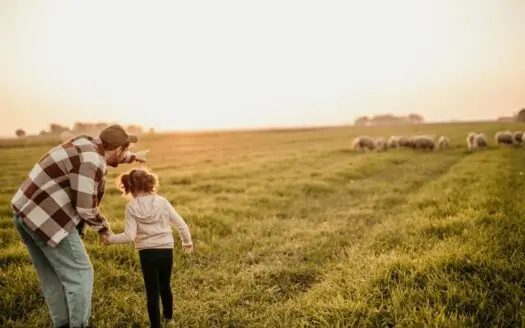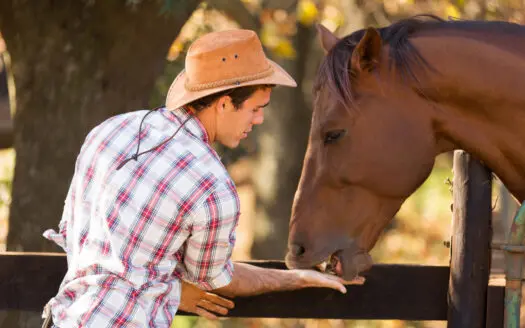History of Texas Ranches | United Country Real Estate
Ranching has been a part of Texas culture longer than the land has been called Texas. The practice of maintaining, breeding and herding cattle and other livestock has been around for thousands of years –likely since the beginning of recorded human history. The term ranch comes from the Spanish ranchos, meaning “small farm” or “country house” as the tradition as it is known today originated in Spain. This comprehensive guide will detail the history of ranching in Texas and the innovations that have been made along the way.
Introduction into Texas Ranching
Ranches in Texas have the highest number of farms in the United States with cotton, cattle, horses and other livestock as the commodities of which the state produces the most. By the time Texas officially became annexed by the United States in 1845, ranching was already a staple in the area. This market changed the shape of settlements, railroads and trails, making a permanent mark on the land. Ranching in Texas has moved the economy, influencing both local lives and tourism.
Early Beginnings: Spanish Influence & Birth of Ranching
Texas’ relationship with ranching began around 15th century when Spanish explorers brought cattle to the Americas. These original cattle, brought over by the Spaniards, led to what we now know as the iconic Texas Longhorn through generations of hybrid breeding. These early ranches were built around water sources, like the Rio Grande, while Spain, France and England were in fighting over territories, and once the conflict ended, the cattle industry started to thrive.
Spanish Missions
Spanish missions were established in the early 18th century around eastern Texas and Louisiana in order to ward off the French, including one mission that was erected in what is now San Augustine, Texas. After the French lost their claim on territory in North America, the soldiers and other personnel that were inhabiting the missions left the area, but the Spanish cattle remained in the nearby prairies. Folks in East Texas starting herding and rounding up the livestock and created a market in New Orleans, which was still a part of New Spain. Many current ranch-based terms used today derive from the original Spanish words such as “mustang,” “maverick” and “chaps.”
Expansion of Ranching
Ranching quickly expanded outside of Texas and spread through the American west by the early 19th century. As the 1800s went on, many innovations in ranching practices, technology and locations expanded. The allure of unclaimed, vast grazing land through Kansas, Colorado, Montana, Wyoming and the Dakotas drew many Texas ranchers and cowboys. The Homestead Act of 1862 sped up the process of settling land in the west as it granted families 160-acre land for at least five years.
Cattle Drives: Trails & Cowboys
Cattle markets in Texas were stretched out into the entire American West throughout the latter half of the 19th century and early 20th century. These ventures would start in Texas and head to railheads in Kansas in order to be sold east of the Mississippi. Due to the need of frequent stops so that the cattle wouldn’t lose weight before sales, cowboys and ranchers formed trails over time, the most famous of these being the Shawnee Trail, Goodnight-Loving Trail, Western Trail and Eastern-Chisholm Trail systems.
A typical cattle herd at this time was around 3,000 heads, requiring roughly 10 cowboys to manage the livestock. The cattle drives had elaborate social systems and jobs with cooks who often also provided medical care, trail bosses, drovers and wranglers, those in charge of caring for the additional horses. It was around this time that the iconic cowboy apparel came around. The boots were adapted to make sure it was easy for cowboys to briskly dismount their horses. The chaps ensured they wouldn’t injury their legs on cacti or other obstacles. Bandanas were made popular as they allowed riders to soak up sweat or protect their eyes from dust. Arguably the most important piece of the cowboy iconography, the cowboy hat, had many uses. Mainly, it kept the sun out of their faces while also working as a tool to bring water to horses as needed.
Dust Bowl
The ranch industry’s growth exploded during the 19th century and early 20th century, especially as the California gold rush ushered people west and more states were incorporated into the Union. In the 1930s, the Dust Dowl caused droughts all over the Great Plains and other rural areas, wreaking havoc upon farms and ranches. Many livestock died or had to be sold and crops withered in the water-less environment.
Beef Boom
Following the Dust Bowl, World War II radically changed the atmosphere of Texas along with the rest of the nation. While Texans contributed the largest number of soldiers than any other U.S. state, the state benefitted from a boom in the main industries in the area. Beef, petroleum, weapons and medical supplies were provided to the war efforts, giving a helpful economic boost for the Texan residents, as well as helping the country secure a win.
Ranching Innovations
As ranching continued to spread across the United States, people sought innovations to making ranching easier and bring the practice into the modern age. Barbed wire was initially patented in 1867 by an Ohio resident, which revolutionized the agriculture industry and is still one of the most prudent factors of effective livestock management today. The appeal of the open range and gold rush drew more individuals and families west, necessitating people to enforce borders and property lines with barbed wire and fencing.
Another critical ranching innovation was the windmill. For centuries, ranches had to be built around water sources, like rivers or lakes, in order to properly provide for livestock. In the mid-1850s, Daniel Halladay adapted windmills from the original German and Dutch style to a version that would work well on American farmland. The windmills were built over wells in order to pump water for cattle, as well as railways, small towns and other places where water was rare. The inexpensive nature of these mechanisms helped windmills become a wide-spread practice that was then further adapted while also being a key contributor to the expansion of the American West.
Legacy of Texas Ranching
Ranching in Texas has left a significant impact, influencing both the economy and culture since its inception up until today. While not quite as much Texan land is dedicated to cattle production or equestrian feats as there was 150 years ago, there are still more than 125 million acres of dedicated farm and ranchland in the Lone Star State. Many aspects from the original ranchers have remained as key aspects of Texan culture while many innovations, such as windmills and tractors, have brought the tradition into the 21st century.
Modernization & Machines
As ranching moved into the modern age, so did the machines and tools used to support them. One of the most basic and essential pieces of equipment for any agricultural land is the tractor. With many key uses, such as tilling and harvesting, tractors are a versatile and widely beneficial tool for any ranch type.
When transporting livestock, feed, equipment or other heavy-duty ranch necessities, one must have a powerful vehicle with plenty of storage and loading space. That is why a majority of farmers and ranchers opt for pick-up trucks over any other car type. Once a truck has been picked out, find a livestock trailer that is compatible for your lifestyle.
These examples are just the tip of the iceberg when it comes to necessary and useful ranch equipment. Investigate which additional tools you need for your specific ranch as different commodities and land types have different requirements.
Rodeos
Rodeos are an important part of culture throughout America, but especially so in Texas. Evidence suggests the first ever recorded rodeos took place in Pecos, Texas on July 4, 1883, proving the long-standing tradition is an integral part of Texan history. The American Professional Rodeo Association was launched in 1922, which became the guiding post for rodeo managers and producers, ushering in an era of more organized rodeo competitions. Almost 50 years later, the Professional Rodeo Cowboys Association was formed in 1975, allowing for more standardized competitions and increasing the popularity of the sport.
There are typically about eight events at a rodeo, including bareback riding, saddle bronc riding, barrel racing, steer wrestling, steer roping, tie-down roping, team roping and bull riding. Each event’s competitors showcase great amounts of athleticism, skill and, most importantly, horsemanship.
Historic Ranches
King Ranch
The largest ranch in all of Texas, the King Ranch was established in 1883 and covers more than 825,000 acres. Richard King was an accomplished and fascinating character who purchased the land after spending much of his life building a riverboat company that transported army supplies along the Rio Grande. Through his travels in the area, he became interested in the Santa Gertrudis Creek grasslands, acquiring more and more land with profits from his company.
The ranch is passed down in the family and was the birthplace of several key moments in ranch history, including the region’s first artesian well built successfully and the invention of the root plow. Most importantly, the King Ranch developed a cattle breed, the Santa Gertrudis, which was the first new cattle breed in more than 100 years and the first ever produce in the United States.
XIT Ranch
The XIT Ranch was founded by the Farwell brothers in 1885 and was the largest ranch in the world under fence. Boasting 3 million acres of Texas Panhandle, the XIT Ranch was the payment Charles B. and John V. Farwell accepted after agreeing to build the capitol building in Austin after the original burned down. Using the red granite from the Panhandle and labor from ox, they erected one of the largest and impressive capitol buildings in the nation –second only in size to the Washington D.C. capitol.
They built their headquarters and corrals in Buffalo Springs, and these structures still stand as the oldest buildings in Dallam County. Shortly after establishing the ranch operation, the first manager of the ranch, B.H. Campbell and cattle driver, Ab Blocker, invented the “XIT” brand as a way to ensure no cattle rustlers could burn over theirs. Longhorns were their initial cattle breed of choice, running about 150,000 at the height of the ranch.
6666 Ranch:
The 6666 Ranch, also stylized as ‘The Four Sixes Ranch’ is a large stretch of land that saw more history in its formative years than most anywhere else. Spanning across four counties of North-Central Texas, Samuel “Burk” Burnett, the founder, secured a formidable legacy with the creation of this ranch. Quannah Parker, a renowned Comanche Chief, President Theodore Roosevelt and actor, Will Rogers, all frequented the land for hunting excursions with Burnett.
Today, you can attend horsemanship clinics, seek veterinary services, purchase award- winning American Quarter horses or even bring the ranch flavor home with the branded beers, seasonings, sauces and beef.
The ranch stayed with the family, growing in size and legacy, until the passing of Burnett’s great-granddaughter, the unequaled Anne Windfohr Marion, in 2020. Upholding her family heritage, she possessed incredible horse knowledge and was inducted into National Cowgirl Museum and Hall of Fame and American Quarter Horse Hall of Fame.
Following her death, the Four Sixes Ranch was sold in the most significant ranch sale of recent history to Taylor Sheridan, creator of hit TV shows Yellowstone and 1883 amongst others, by Don Bell of United Country Real Estate | Don Bell Properties.
Sources:
texasneighbors.texasfarmbureau.org
education.nationalgeographic.org



